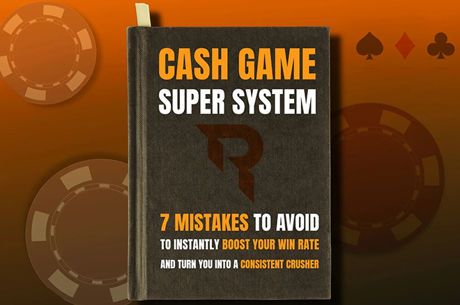How to Play Ace-Queen Offsuit in Common Preflop Situations

Table Of Contents
- Unopened Pots
- Against a Raise
- Against a 3-Bet
- Against a 4-Bet
- 3 Tips for Playing When You Miss the Flop With AQ
- Tip #1: You can still bet when you miss the flop if the board is not connected
- Tip#2: You can sometimes check-call when you miss from the big blind
- Tip#3: When the board is connected and you have nothing, it’s best to fold
- Wrapping Up
Some hate it, some love it. Ace-queen offsuit (AQo) is one of the most polarizing hands in poker.
It is no wonder why. AQo is one of the best starting hands in the deck, but it can also be relatively difficult to play compared to other strong starting hands.
This article covers:
- How to Play Ace-Queen in Common Preflop Situations
- 3 Tips for Playing Ace-Queen When You Miss the Flop
Now, let's begin.
Unopened Pots
Even poker beginners can identify AQo as a strong hand. After all, it includes two of the three highest-ranking cards in the deck.
For this reason, you should always raise with this hand preflop from every position when the action folds to you. Avoid limping with AQo as it will lead to smaller pots being won by you on average over time. Folding is out of the question.
Against a Raise
When faced with a raise, you should 3-bet with this hand almost every time. The one exception is when you are in the big blind facing a raise from a player seated in the cutoff position or earlier (3-betting big blind vs button is usually good).

Ace-Queen offsuit plays great as a thin 3-bet for value since it cuts down the field. 3-betting massively reduces the chances of playing a multiway pot, and you should not want to play multiway pots with ace-queen because rarely makes strong flushes and straights (a key component of hands that play well multiway).
Pro tip: When you're playing in a 9-handed game, you can oftentimes just fold with this hand when the first player (UTG) raises and you are seated in the cutoff position or earlier. This is because an UTG range is simply too strong and there are too many players behind that can cold 4-bet you. The exception is when you are on the button, in which case you will want to cold-call with this hand as there are only two players behind and you will always be in position after the flop.
Against a 3-Bet
When faced with a 3-bet, Ace-Queen offsuit can perform great as both a call and a 4-bet bluff.
The hand works well as a 4-bet bluff when the 3-bettors range is tight because the hand’s blocker effects are more impactful. AQ blocks half the possible combinations of AA and QQ, and a quarter of the combinations of AK.
These blocker effects mean that when you 4-bet bluff with AQo, you will face a 5-bet shove significantly less than, say, if you were holding K5 suited. AQo also has a lot of equity against a typical 4-bet calling range, which often includes middling pairs, suited aces, and suited connectors.
To make this a bit simpler, you should generally call with AQo against a 3-bet when you are seated in the hijack through the small blind. In the rest of the positions, consider 4-betting as a bluff. So, for example:
- Hijack vs Button 3-bet -> call
- Cutoff vs Big Blind 3-bet -> call
- UTG+1 vs Cutoff -> 4-bet sometimes
- Lojack vs Cutoff -> 4-bet sometimes
Against a 4-Bet
When facing a 4-bet, you will generally want to fold AQo. It has served its purpose of attempting to get thin value against the calling range and denying some equity.
The only situations in which you will not want to fold vs a 4-bet is in late position battles where the ranges are much wider. Namely, from the small blind against the button or from the big blind against the small blind. The ranges involved here are so wide that this hand is still strong enough to continue by flatting against 4-bet.
Note: Want to know how to play every hand in every common preflop situation? Get instant access to extensive preflop charts and lessons (for cash games and tournaments) when you join the Upswing Lab training course. Lock your seat now!

3 Tips for Playing When You Miss the Flop With AQ
Tip #1: You can still bet when you miss the flop if the board is not connected
When in position as the preflop aggressor on a fairly disconnected flop, you will want to fire a continuation bet (c-bet) with AQo, even if you don't have a draw.
With either three or six outs to hit top pair, your hand will have enough equity to make it worthwhile as a semi-bluff. If you do hit top pair on the turn, you can comfortably triple barrel for value (usually).
Tip#2: You can sometimes check-call when you miss from the big blind
After defending from the big blind, you will want to check-call on the flop if you have at least one overcard and the nut backdoor flush draw.
For example, let's say you call A♠Q♣ from the big blind after facing an UTG open and the flop comes down J♥6♠2♠. Your specific combination of Ace-Queen offsuit can call a c-bet because you hold the A♠, which can improve to the nut flush draw or top pair on the turn.
You can even bluff with it on the river when the runout is such that you would be hard-pressed to find bluffs. For example, if the turn is the 5♠ and the action checks through, you can probe on the river as a bluff. Since all of your flush draws have hit, your opponent may have a hard time putting you on a bluff.
Tip#3: When the board is connected and you have nothing, it’s best to fold
Yes, you had a great hand preflop. But now you have settled into a part of the game tree where AQ doesn’t have much expected value, and that is fine.
Don’t feel like you need to win every pot just because you had a great hand on the previous street!
Sometimes you just gotta give it up and move on to the next hand.
Wrapping Up
If you enjoyed this article focusing on a single hand, please let us know by leaving a comment down below.
Want to learn how to play better with another powerful starting hand? Read 5 Strategic Mistakes to Avoid with Pocket Aces.
Until next time, good luck, grinders!
Note: Ready to join the 6,112 players currently upgrading their No Limit Hold’em skills? Join the Upswing Lab training course and learn step-by-step how to become the best player at the table.
Elite poker pros have been adding new content to the Lab every week for the past four years, and you get all of it when you join. Learn more now!
Sponsor-generated content by Upswing Poker









